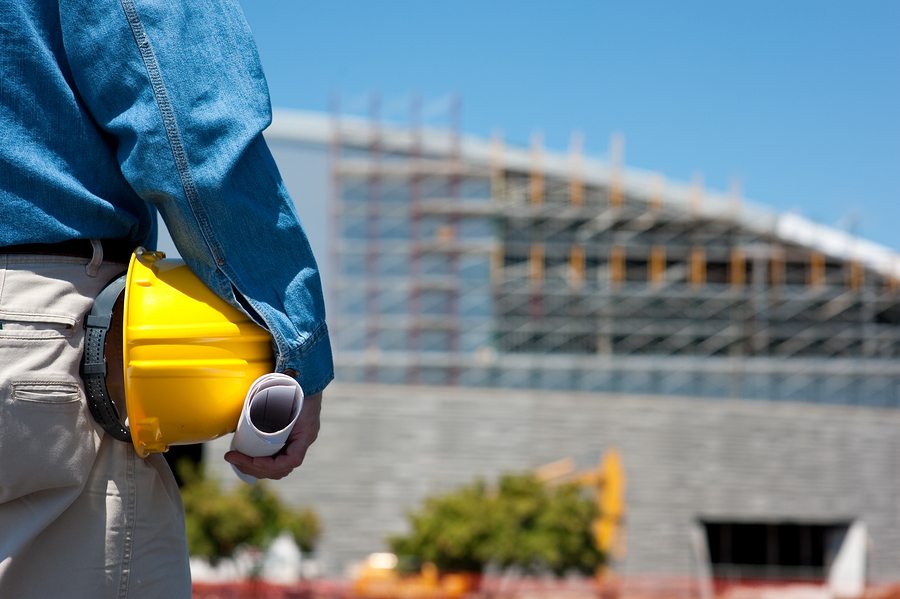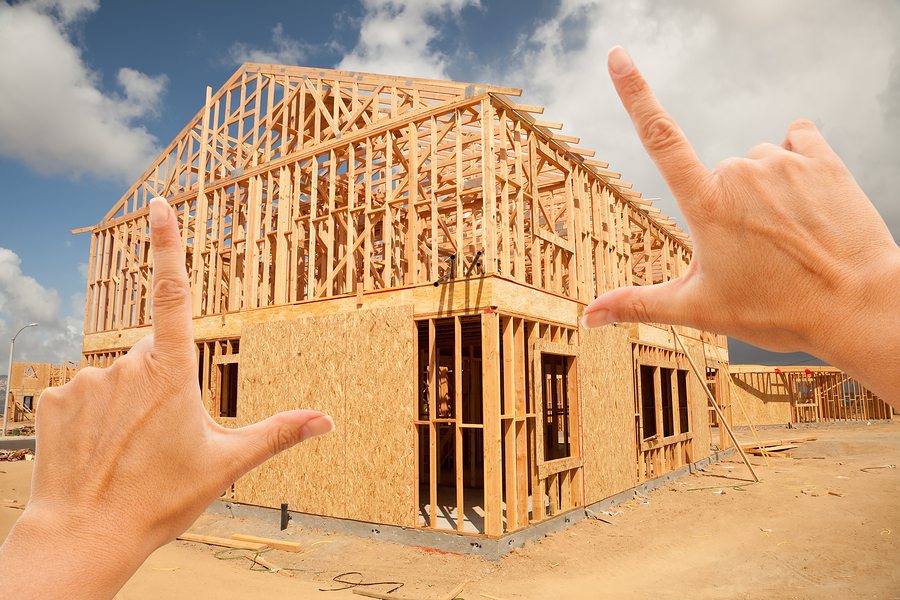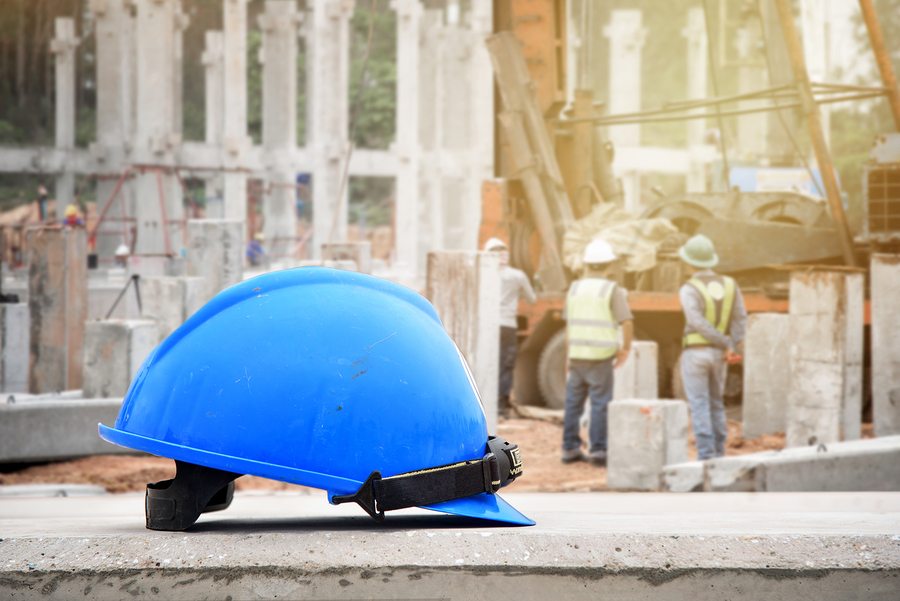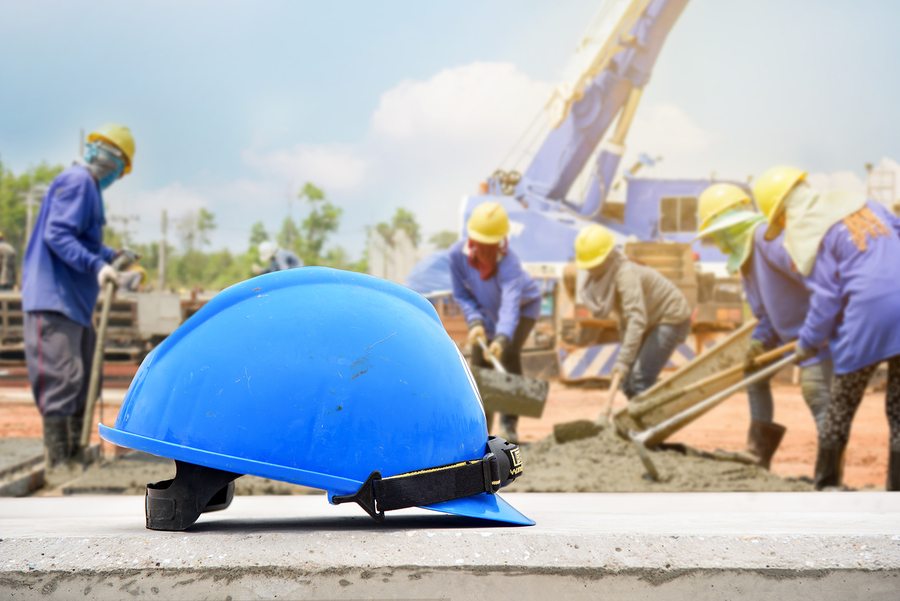by jeffp | Jan 16, 2018 | Construction

It’s shaping up to be a busy year for building. Already, construction companies and tradespeople are finding ways to stay ahead of the pack. See what others are doing to improve construction and building in 2018.
1. Build Modular
One of the newest trends in construction is the building of modular dwellings, units, and other fabricated parts. Building on one location before delivery allows for greater environmental and waste control. It can also help limit liability by increasing control over access to the construction site, tools, and materials. The tiny home movement, modular mid- and high-rises, and other offsite construction methods are growing in popularity.
2. Embrace Technology
Nearly any aspect of construction can be augmented with a technological device, software, and other advancements in tech. While it’s possible to lean too much on technology, a balance of the right tech can add exponential value to a project. Drones, cloud sharing, GPS tracking and enhanced employee communication are just a few of the many options available. Be sure to follow all applicable local and federal laws utilizing drones and other technology. Design tools, virtual meetups and more can increase productivity utilized correctly. Find the right tools for your team and accomplish more.
3. Attract Talent (and keep it!)
Labor shortages are already apparent; some companies are grappling with more work than skilled labor to complete it with. For others, projects-in-progress have been placed on pause due to immigration enforcement. To stay ahead of the competition, some construction companies are offering better pay and benefits. Others are relying more on temporary labor. Finding help may become a challenge, be prepared to court skilled tradespeople and work diligently to retain them.
4. Go Green
Environmental awareness is growing and companies with a reputation for green policies are more likely to see revenue. Material waste and disposal, resource consumption, and environmental impact can affect company image. Wherever possible, implement sustainable policies and be sure to comply with all federal, state, and local laws. Expect this trend to continue. Companies taking a proactive approach will be better positioned for further legislative changes.
5. Control Costs
Almost ten years after the housing crash, lenders have yet to release funds with the same willingness as before. Materials costs are high, and increased costs for attracting labor add to the challenges of doing business this year. This year, more builders are contracting into public-private partnerships with government agencies. In this partnerships, public funds and assets can be made available for hiring private companies. This can be a great way to maintain infrastructure while stimulating the economy, and more builders are discovering the value.
6. Building Information Modeling
The latest in construction innovation, Building Information Modeling (BIM) is a great tool for improving the construction process. Building Information Modeling is a design and management tool. Builders, architects, and others in the design and construction process can collaborate with this BIM to deliver a winning project. Building Information Modeling can also have a positive impact on workplace safety and compliance and can help limit expenses. For more on BIM contact a Business Information Modeling firm or expert.
7. Communicate
While perhaps an older concept, communication on the job site can almost always be improved. Today, multiple digital solutions for encouraging and improving communication are available. Builders have schedules to keep and communication can help increase efficiency and safety. Missed deadlines, liability claims, and materials waste can add up. Stay on top of projects with clear, competent communication.
Approaching 2018 with a positive attitude can help gain the edge over the competition. Review practices to see where improvements can be made and see how much more business is possible. Come back often for more on ways to improve efficiency and save money.
by jeffp | Jan 13, 2018 | Construction

Builders spend a lifetime perfecting their craft. Fortunately, some are willing to share some of their best tips and tricks. Here’s a quick rundown of several inside tips from the pros.
Laying the Groundwork
Installing flooring can be challenging depending on the materials and surface. Taking time to ensure a level floor will improve the finished product. Installing an effective subfloor can help with creating a level surface, yet the glue can be messy and difficult to work with. To install subflooring without the mess, gently lower subfloor with a garden digging tool. Applying pressure to the leading edge, install subfloor without the mess.
The Frame Game
Most homes have imperfections and the older they get, the greater those imperfections become. Homes settle and before long, floors and walls begin to curve, slope, or separate. Before making cuts or installations, learn the acceptable tolerances. Some aspects of construction must be perfectly level or straight. Knowing where to make adjustments will make the process much easier, and help create a better result.
Frames must be straight, so it’s important to start with a level foundation. Mudsills allow for some flexibility while rim joists must be cut within 1/10th an inch accuracy. Walls can bow a bit, as long as kept within an acceptable limit. Walls can bow up to 1/4″ vertically for each 8′ section, and 1/4″ horizontally for each 50′ section without compromising structural integrity.
The frames in a home support plumbing, electrical, HVAC installation and more. An accurately-installed framework will help make following projects easier to complete.
Selecting Good Wood
Lumber varies by retailer, batch, and tree. Selecting the lumber for framing, look for straight and durable boards. Curved, bowed, or rotted boards will create a weak or imbalanced foundation from the start. Cabinets, doors, and walls require straight walls to function properly. Selecting the right wood, at the beginning, will help the entire construction project.
With any construction project, selecting the right materials and tools helps. Before tackling a construction project, ensure home insurance is in place to cover potential damages to the new or existing space. Always place safety at the top and ask a professional before working with dangerous materials.
by jeffp | Dec 25, 2017 | Construction
![]()
In construction, efficiency matters. Companies that want the most from a project have to balance resources and deadlines to be effective. On the flip side, companies that struggle may create unsafe environments. Increased pressure on workers can lead to an increase in job site risks and an increase in insurance premiums. Improve productivity and reduce insurance rates by employing effective construction site management. Finding the right people and granting them the tools for success will help reduce risk, leading to savings across the board. Here are four ways to help construction managers perform at their peak:
Standardize Company Processes
Today, companies across the board are standardizing their processes. For companies experiencing growth, processes are often essential. A process defines a system for accomplishing specific tasks. By creating and utilizing intelligent and effective processes, risks are greatly reduced. With a reduction in risk inevitably comes a reduction in workplace accidents, reducing insurance costs. The right process is one built around the company; a business coach or consultant may be able to offer guidance. Record processes and train staff to follow them.
Utilize Technology
Construction of a building is but one small portion of an overall construction project. A large number of administrative resources are involved in building. Planning, compliance, resource management, billing and more all play significant roles. As companies grow, the number of persons involved in each project tends to grow as well. Moving staff onto shared digital platforms, utilizing file sharing services, and group messaging technology can all help managers become more efficient.
Plan Efficiently
On a construction site, time is money. When employees are standing around, their time can become expensive. Proper planning can help get the most out of staff and dodge paying for extended breaks or milling about. The more moving parts involved, the more challenging this can become. To help improve efficiency and reduce risk, ask employees to be conscious of workday planning. In some cases, a consultant may be helpful in creating and streamlining schedules.
Encourage Communication
A staff that communicates well is likely to be safer and more efficient. In the construction and building trades, risks abound. Effective communication can help reduce risks and at the same time, greatly improve efficiency. The right blend of communications strategies will depend on the size and makeup of an organization. For most companies, the following tips can help improve the workplace:
- Collaboration. Encourage staff to share thoughts. Oftentimes, there are great solutions right within the company. Create a positive environment for communication.
- Clarity. Be clear about goals, objectives, timelines and more. Employees should be familiar with processes and know where to ask for help.
- Conversation. Staff members may be the first to spot a workplace hazard, or perhaps a more efficient process. Encourage feedback to management.
With an increase in workplace safety often comes increases in productivity and morale as well. Limit risks to reduce insurance premiums and get the most out of each construction project. Construction companies with strong management and a strong workforce are more likely to:
- Meet or exceed expectations
- Reduce risks to property, staff, and equipment
- Balance scheduling
- Gain a positive reputation in the industry
An investment in creating clear and effective processes can pay dividends. For questions about insurance for builders and protecting construction sites, contact an agent today. Visit often for more information on improving safety and saving money.
by jeffp | Nov 23, 2017 | Construction

In the construction industry risk is inherent. Those able to assess and mitigate risk increase their chances for success. On the job site safety is an attitude. The right methods, equipment, and crew can help keep sites and people safe. For those behind the scenes, the risks are met with comprehensive construction insurance protection. Construction projects take all shapes and forms. Protection tailored for each project will offer maximum coverage for the best rates, helping improve the bottom line.
Projects large and small tend to include third-party contractors for some portion of completion. Landscape architects, HVAC professionals, and other design professionals may be contracted to perform a portion of construction. Add layers of protection to design and builder contracts with the right insurance protection. Tailored policies include coverage for job-specific risks. The strongest contracts include professional liability, auto and commercial liability, and employer’s liability; also referred to as workers’ compensation. As the builder, it’s reasonable to ask for this upon entering into agreements. For added coverage, homeowners and builders may wish to ask for pollution insurance as well.
Experts recommend including insurance protection as part of contracts with those performing the work as well. The subcontractors working on the construction site should be licensed and bonded. It is also recommended they carry personal liability insurance and workers’ compensation protection. Depending on the contract excess and professional liability may prove smart additions to a policy. For larger projects, builders and lenders can add owner’s protective professional insurance to a policy. This addition covers gaps in coverage from those contracted.
Liability insurance protects builders, lenders, and design professionals in 3 different ways:
- Protection from claims against the company or staff
- Coverage for damages caused by the company or staff
- Assistance with unexpected expenses during claims
A construction project can involve many people over the course of completion and may last longer than expected. The chances the unexpected can occur are high; ask an agent about professional liability insurance.
Builders Risk Insurance Protection
The protection from liability insurance extends to staff and damages caused during construction. This leaves a gap in protection for the physical structure. For home construction projects homeowners can opt for construction insurance for active projects yet these carry significant limitations. For extra protection builders-risk insurance offers advantages for all parties. A single policy is sufficient and may be purchased by either the homeowner or contractor. The following details may help determine which party might procure builders risk insurance for the project:
- Location of the project
- Lender insurance requirements
- Type of construction project
Some contractors may automatically carry builders risk. For more information on builders-risk policies and insurance protection contact an agent.
Protect Investments
Liability and builders-risk insurance create a safety-net for construction projects from start to finish. Construction insurance has advantages for homeowners, builders, and contractors. For extra protection and to cover project-specific requirements, additional insurance policies are available. Speak to an agent to create a complete shield of insurance protection for construction projects.
For more information on insurance for construction projects, home builds, building renovations and more call an agent today. Get affordable coverage and gain peace of mind. Our team is happy to answer questions.
by jeffp | Nov 18, 2017 | Construction

Construction builders will want to hear this: OSHA’s Directorate of Enforcement Programs is getting serious about the silica standard. In a recent memo, acting director Patrick J. Kapust says that as of October 2017, OSHA is going to enforce all the provisions of the silica standard. This can be challenging for some companies, as compliance and insurance costs can change.
The new standard creates guidelines for construction companies. Under the OSHA standard, exposure limits of 50 µg/m3 and an action level of 25 µg/m3 are the maximum allowable in an eight-hour period. This standard has been in place since September, allowing companies to conform to the new standard prior to official OSHA enforcement.
This memo is the interim directive while the final regulation language passes through the formal review process. Once the regulation is finalized it will replace this and any other related OSHA memos. Agents in the field will operate off the most-recently issued directive.
Several options for protecting against silica inhalation are available. Particle catchers, exhaust systems, and personal respirators all help protect employee respiratory health. This helps employees lead happy and healthy lives, and also reduces company insurance risk.
For more information on OSHA compliance for silica and other safety regulations, contact the Occupational Safety and Health Administration at 1-800-321-OSHA. Industry regulations affect insurance premiums and requirements. For more information on how OSHA rulings affect construction companies contact an agent today. For insurance quotes, questions about coverage, or any other insurance matters call an agent anytime.
by jeffp | Oct 17, 2017 | Construction

Building during hurricane season carries risks for entrepreneurs and construction companies. Storms tear into construction sites ravaging materials and destroying site preparation. Beyond the physical toll, construction companies shoulder extra staffing, transportation, and other costs due to delay. Construction continues year-round, regardless of hurricane season. Each year, builders take a gamble projects will safe from major storms. Builders risk insurance protects residential and commercial construction projects from damages caused by storm activity.
Often, the language in a builders risk plan is specific to an insurance agency. Standardized insurance formats for builders risk plans have yet to take hold, making these plans difficult to understand. This leaves many entrepreneurs and builders in a lurch if insurance claims are filed. Many claimants receive less compensation than owed. This is due to confusing policy language and coverage on most builders risk plans.
Builders risk protects projects under-construction. This includes protection for plans, materials, tools and more. If a claim is submitted there are a number of steps the insured is expected to take. Rigid timelines, complicated paperwork and more create hurdles for filing in the requisite amount of time.
Builders Risk Insurance: Claims
Filing claims correctly and on-time helps avoid unnecessary claim denial or delay in compensation. To increase chances for compensation without delay or rejection, here are 5 steps for filing a builder’s risk insurance claim:
1. Understand the Builders Risk Policy
Insurance policy paperwork grows in size with each added layer of protection. Arrange proper coverage with an agent and review all policy materials. A solid understanding of coverage protection, policy limitations, claims processes and timelines all help expedite the claims process.
2. Build an Insurance Claims Team
A designated team of individuals dedicated to insurance matters expedites the claims process. Persons educated on processes, language and timelines for filing builders risk claims are better able to react to damages. Teams may include members from legal, accounting, management sections and more. Train teams to respond to insurance matters and improve chances for the effective filing of claims for compensation payout.
3. Create a Single Point of Contact
Insurance claims are legal matters where the right language matters. Create a single point of contact on the claims team for communicating to the insurance agency. Insurance agencies take statements into effect deciding claims; ensure statements are controlled. Including legal counsel for representatives creates additional protective layers.
4. Thoroughly Record Losses
On a builders risk insurance claim, the details matter. Record all losses regardless of size. Independent experts are a valuable resource for thorough inspection of potential losses. This helps capture all potential insurance payouts for both hard costs and soft.
5. Contact Insurance Carriers Promptly
Builders risk policies created by local agencies often bundle services from several carriers for complete protection. Each of these carriers extends coverage for specific risks, shouldering a percentage of claim responsibility. For claims filing, contact each carrier promptly and begin the claims process.
Unexpected weather wreaks havoc on construction projects of all sizes each storm season. Builders risk insurance protects from losses due to hurricane and storms. To find the right builder’s risk policy talk to an insurance agent. Builders risk policies are tailored to fit. A local insurance broker has the best perspective on coverage necessary in your area. Contact an agent today and discover all the layers of protection available under builders risk insurance.
Have questions related to personal and business insurance matters? An article topic to suggest? Contact an agent today!







